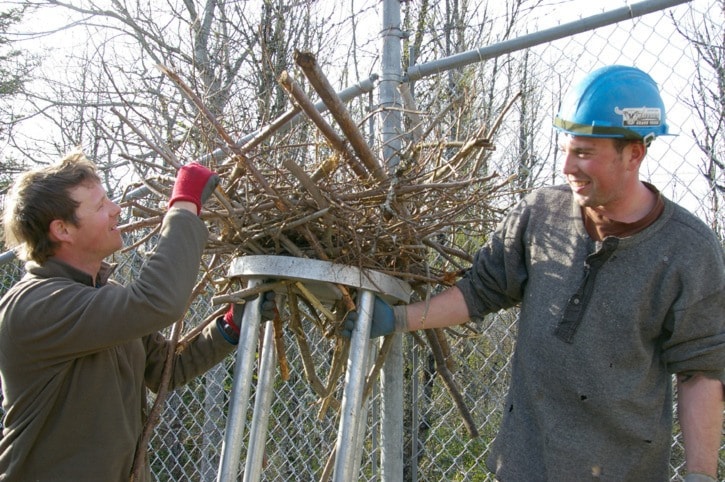Cell workers rebuild home destroyed in windstorm
A nesting osprey kept a watchful eye on workers scaling the Telus cellphone tower in Colwood this week.
A nest was blown off the tower in a March windstorm, and the lone male raptor seemed eager to reestablish his home in Belmont park. The osprey circled the tower with twigs in his beak and squawked at the workers. Little did the bird know the workers intend to help him make up for lost time.
Work to add 4G technology to the tower is complete, and an extension was attached to the top of the pole with a ready-made nest for the osprey.
“Telus had planned to upgrade technology on the tower a few years ago, but when we saw the nest work stopped,” Telus spokesperson Shawn Hall explained.
Osprey nests are protected year-round by the B.C. Wildlife Act. To remove one requires a permit, which Telus was in the process of obtaining. When the nest was blown down naturally, workers were free climb the tower.
Wildlife biologist Sean Pendergast with the B.C. ministry of forests, lands and natural resource operations said if the nest hadn’t fallen, it’s likely a permit would have been granted.
“Osprey are notorious for nesting on man-made structures. They like to be on the highest, most exposed point in an area so they can watch for predators,” he said. “It’s unfortunate when they choose something that needs regular maintenance.”
He said Telus, because it didn’t actually remove the nest, is under no obligation to replace it.
“They’ve gone above and beyond to accommodate the osprey,” Pendergast said.
Hall estimates the company will spend $15,000 to $20,000 ensuring the osprey can continue to nest around its tower. The new nest extension going on the pole is a temporary fix — Telus intends to eventually erect a stand-alone tower with a platform just for the bird.
“We want him to have a permanent home, off our active towers, so our guys don’t need to worry about disturbing the nest,” Hall said. “We’re in a situation now that if we needed to do emergency maintenance during the months the birds live there, we wouldn’t be able to access the tower, we’d have to wait.”
Pendergast said ospreys are quite resilient and don’t seem to mind when humans move their nest to a new structure when they’ve gone south for the winter.
“Often if you just put a few sticks from the nest onto the new platform, when they return they’ll take to the new location,” he said. “They’re not picky.”
Site foreman John Switzer of WestTower Communications, the contractor working on the Telus tower, is proud of the nest he and his co-worker Kyle Cronin built for the osprey, which they’ve affectionately nicknamed Daren.
“It’s my first time building a nest. I think he’ll like it,” Switzer said. “We collected up the sticks that had fallen from his other nest and grabbed some bigger branches from the bushes.”
While his crew was working, some residents accused them of destroying the osprey nest, but Switzer said if people saw an osprey nest on the tower recently, it was only the one they built. The crew had mounted their handmade nest on the tower for a few hours last week, but found the bird started acting territorial around it, endangering the workers.
“We’re rushing though this work, working seven days a week, so we don’t upset the osprey more than we have to,” he said. “We’ll put the nest back up when we’re finished.”
Ospreys are migratory birds that come to the Island and other parts of Canada to mate each spring. Males arrive in March, April or May to build a nest near a water body. They often reuse old nests, adding new material to them each season.
Females arrive later, moving into the nest where the pair will remain for five months, raising two to four young on a diet of fish.
Colwood Mayor Dave Saunders, who sits on a municipal task force concerned with the proliferation of transmitters on communication towers in urban areas, was among those questioning Telus about the work happening on the tower—but not because of the nest.
“We have a municipal bylaw requiring we be consulted before additions are made on existing towers,” he said. “Nobody told us work was planned at that location.”
He contacted Telus and the company readily filled him in on the work being done. Still, he would have liked to find out before the job was underway.
Telus maintains it’s operating by Industry Canada standards which overrides the municipal bylaws on federal land.
Saunders said the task force is also concerned with the citing of the Belmont park tower in particular.
“It’s one of the ones we’d like to see relocated to an area away from homes,” he said. “Some members (of the task force) are concerned about health impact (of radiation) for people living too close to towers.”
news@goldstreamgazette.com
